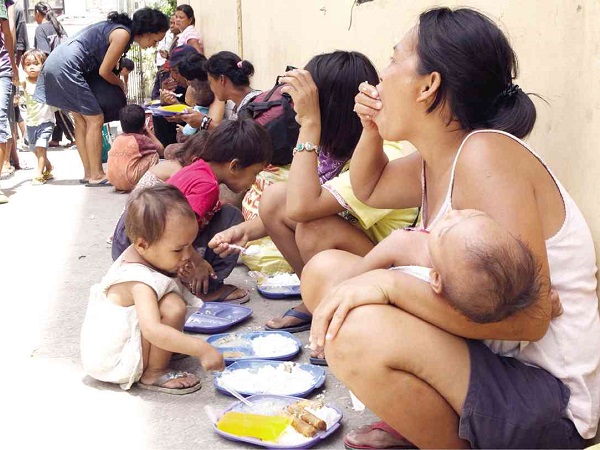A weekend food hub for Cebu’s poor

CHILDREN and their mothers are among the 300 people who partake of the free meal from Kusina Plus Panaderia ni Sta. Marta, a feeding center being operated by the Cebu archdiocese inside the Caritas compound in downtown Cebu City. Lito Tecson/ Cebu Daily News
CEBU CITY—Laundrywoman Virginia Barric left her home in Toledo City to try her luck in Cebu City, about 50 kilometers away. She didn’t find any.
Now 70 and blind in the right eye, she would roam the streets, looking for tin cans and plastic bottles to sell at a scrap yard. Every week, she collects 3 kilograms of junk for which she gets only P30—hardly enough to buy a meal for a single day.
Barric is alone in the city and she can’t go back to Toledo because she no longer has a home there. She stays at Citi Center Commercial Complex in Barangay Kamagayan, which the city government plans to demolish for a housing site for its employees.
Despite the harshness of life, Barric has something to look forward to every Saturday and Sunday—a delicious free meal. She and about 300 beggars, street children, homeless and the elderly would flock to the Caritas compound in the downtown area for that sumptuous lunch of rice and two viands from a menu of afritada (braised pork in tomato sauce), humba (stewed pork), ngohiong (Chinese lumpiang ubod), lumpia (pork spring rolls), pancit (noodles), spaghetti and embutido—plus fruit juice.
Volunteerism
Article continues after this advertisementThe Archdiocese of Cebu has transformed a dilapidated structure into a cooking and feeding center called Kusina Plus Panaderia ni Sta. Marta to serve the poor.
Article continues after this advertisementRyan Gedorio, 30, and one of the four cooks, said the kitchen usually consumed about 25 kg of rice, 15 kg of meat, packs of spices, and jars of cold juice every feeding session. Once cooked, the food is served right away, and the guests can eat as much as they want—until supply lasts—but they have to be there not later than 2 p.m.
The plates, spoons and forks are washed and sterilized for the next use.
Gedorio, who works in a canteen on weekdays, doesn’t receive any salary at the feeding center but gets P250 in allowance for his volunteer work.
“We are here for the service. I could not explain the fulfillment that I feel. At the end of the day, I just realize that I’m able to help people,” said Gedorio, who hails from Alegria town.
Archbishop Emeritus Ricardo Cardinal Vidal started thinking about putting up a feeding center in 1981 when he first came to the Cebu archdiocese as coadjutor archbishop.
“When I was still residing at the Archbishop’s Palace, I usually found some children outside the gate. They dug up on something from the boxes of garbage. I asked them, ‘What are you doing? That’s garbage.’ And they told me they were looking for something to eat,” Vidal said.
He encouraged parishes to establish feeding programs for the poor and later thought of setting up a feeding center—complete with a kitchen. He sought the help of Msgr. Achilles Dakay, who was then the assigned priest in a church at the Associated Labor Union compound.
Vidal gave Dakay a room inside the Caritas compound, beside Cebu Metropolitan Cathedral, where the feeding center would be built. Dakay said the rundown room was remodeled to look like a kitchen.
Vidal said he never had difficulty getting donations for the project. These included two freezers, two huge rice cookers, six stock pots, and kitchen utensils.
No discrimination
“The Cebuanos are very generous. They know where they are going to put their money,” said Vidal, who has been living in Cebu for 32 years. He retired in 2011.
A bakery would later rise inside the feeding center. “It was originally called Kusina ni Sta. Marta until we added the word ‘panaderia.’ Now it is called Kusina Plus Panaderia ni Sta. Marta,” Dakay said.
Sta. Marta was the woman who prepared the food and served Jesus during one of his visits to Bethany.
“The idea is to really feed the hungry among the poor at noon time,” Dakay said.
Sta. Marta’s kitchen opened its doors to the hungry in 2009. “We just have to feed the hungry,” Dakay said. “We don’t discriminate against those who are not churchgoers because Christ did not say to feed only those who go to church.
Some have criticized the program as a dole since they were not teaching the poor to be self-reliant but to instead wait for a free meal.
“But the question,” Dakay said, “is when you teach and they are hungry, how can they learn?”
“Teaching them how to fish is another program. But in the meantime, what we do is to feed the hungry,” he said, referring to a Confucius saying, “Give a man a fish, feed home for a day. Teach a man to fish, feed for a lifetime.”
The beneficiaries of the feeding program are just happy to have a respite from life’s difficulties.
“I am just thankful that there is a feeding program every weekend because I have no other means of livelihood,” said Danny Cloma, 59, who was forced to stop working as a security guard six years ago after he had a heart attack that paralyzed the left part of his body.
“I just continue to pray to God. He alone knows what will happen to me,” he added.